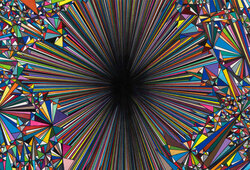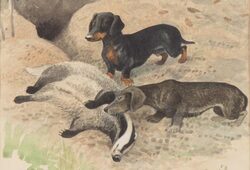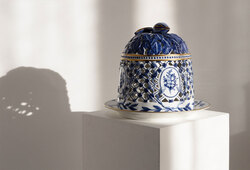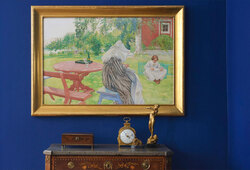Olle Bonniér
TEXTIL, "Raxt", Olle Bonnier, Ljungbergs textiltryck, 2000-tal.
Tryckt dekor i form av geometriskt mönster. 198x129 cm.
Smärre fläckar samt smuts.
Provenance
Stiftelsen Formens Hus, Hällefors.
More information
Det ambitiösa projektet i Hällefors, med en postgymnasial designutbildning – FIDU (Förberedande
Industridesignutbildning) som tillsammans med reklammannen Torbjörn Lenskogs samling av
1900-talets industridesign har exponerats i ett för ändamålet skapad byggnad, har fått ett avslut.
En del av samlingen säljs på Höstens Contemporary på Bukowskis, och en del här på Bukowskis Market. Samlingen innehåller ett stort antal designföremål som väl representerar 1900-talets utveckling.
Från Formens Hus kommer även en intressant samling böcker som spänner över gränserna mellan arkitektur, konst och design. Bland annat finns det böcker av och om Le Corbusier, tidskrifter som berör Stockholmsutställningen 1930 samt H55, utställningskataloger från svenska och internationella konstutställningar samt en del intressanta internationella arkitekturböcker.
Samlingen Formens Hus utgjorde en ”Study Collection” för FIDUstudenterna
likväl som ett publikt museum.
Designer
Olle Bonniér was born in 1925 in Los Angeles. He studied at the Technical School under Issac Grünewald and made several study trips to Europe. Bonniér preferred non-figurative expressions and was interested in the dynamic between colour and form. He had his grand breakthrough with his exhibition “Ung Konst” at Färg and Form, where a group of young radicals came together to form the intellectual association known as “Men of 1947”. This name was somewhat misleading as it excluded the female artist is the group Randi Fisher. Other participants included Lennart Rodhe, Karl-Axel Pehrson, Pierre Olofsson, Olle Gill, Lage Lindell, Armand Rossander och Uno Vallman samt skulptörerna Liss Eriksson and Knut Erik Lindberg. Of the artists which focused upon pure concretism, Bonniér was one of them. In the beginning his painting style consisted of vivid colours, which later turned into more contrasting colours, often black and white. During the 1950s Bonniér edhered to a more poetic painting style. Bonniér is undoubtedly one of Swedens most important representatives of concretism.
Read more






















